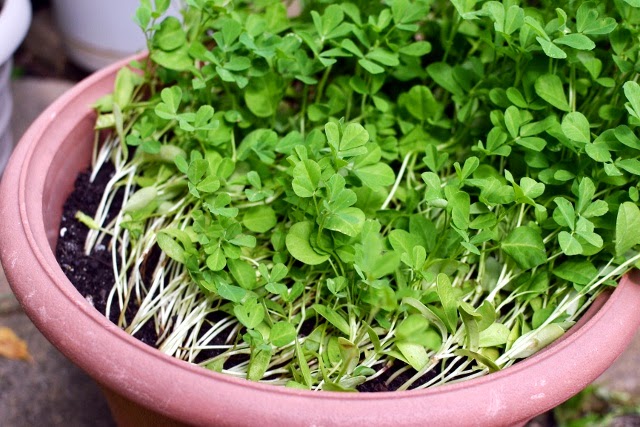Blogging Marathon# 32: Letter M
Theme: A-Z Dishes from Andhra Pradesh
Dish: M for Menthi kura Pappu
Kandi pappu (Toor dal/ split red gram) - ½cup
Tamarind pulp - 1tbsp
Turmeric powder - ¼tsp
Asafoetida (hing) - ¼tsp
Green chilies - 2, slit
Curry leaves - 8-10
Salt - to taste
For tempering:
Mustard seeds - 1tsp
Cumin seeds - 1tsp
Dry red chilies - 2-3
Method:
.jpg)
Logo courtesy : Preeti
Check out the Blogging Marathon page for the other Blogging Marathoners doing BM# 32.
L for Lauju/ Laskora (Kobbari Lauju)

Theme: A-Z Dishes from Andhra Pradesh
Dish: M for Menthi kura Pappu
Letter M stands for fruits & veggies like Mamidikaya/ Mamidi pandu (mango), Menthikura (fenugreek leaves) etc. For today's post, I made a simple dal with Menthikura. I planted methi in my container garden and used it to make this tasty dal. Methi is probably the easiest to grow, sow some methi (fenugreek seeds) and within a week you have tiny methi leaves growing.

Pappu or dal is the main source of protein in our diet and is made almost everyday. This is a very basic recipe and any greens can be used instead of methi.
Ingredients:
Menthi kura (Methi) - 2 cups, chopped
Pappu or dal is the main source of protein in our diet and is made almost everyday. This is a very basic recipe and any greens can be used instead of methi.
Ingredients:
Kandi pappu (Toor dal/ split red gram) - ½cup
Tamarind pulp - 1tbsp
Turmeric powder - ¼tsp
Asafoetida (hing) - ¼tsp
Green chilies - 2, slit
Curry leaves - 8-10
Salt - to taste
For tempering:
Mustard seeds - 1tsp
Cumin seeds - 1tsp
Dry red chilies - 2-3
Method:
- Pressure cook toor dal with a pinch of turmeric until very soft.
- Heat 2tsp oil in a medium saucepan, add mustard seeds,cumin seeds and red chilies; once the seeds start to splutter add the chopped methi leaves and cook covered until they are tender, about 3-4 minutes.
- Add tamarind paste, asafoetida (hing), turmeric and salt. Simmer for 5-7 minutes for the flavors to mingle.
- Next add the cooked dal, green chilies, curry leaves and cook for another 3-4 minutes.
- Serve hot with steamed rice or rotis. I served with rice and kakarakaya podi kura.
.jpg)
Logo courtesy : Preeti
Check out the Blogging Marathon page for the other Blogging Marathoners doing BM# 32.
Previously on A-Z Vegetarian Dishes of Andhra Pradesh:
A for Aava Pettina Aratikaya Kura
B for Bagara Baingan
C for Chimmiri
D for Dosakaya Pachadi
E for Erra Gummadikaya Pulusu
F for Firni
G for Gongura Pulihora
H for Haleem/ Vegetarian Haleem
I for Iguru/ Vankaya-Senagapappu Iguru
J for Jonna Pindi Kudumulu
K for Kakarakaya Podi KuraA for Aava Pettina Aratikaya Kura
B for Bagara Baingan
C for Chimmiri
D for Dosakaya Pachadi
E for Erra Gummadikaya Pulusu
F for Firni
G for Gongura Pulihora
H for Haleem/ Vegetarian Haleem
I for Iguru/ Vankaya-Senagapappu Iguru
J for Jonna Pindi Kudumulu
L for Lauju/ Laskora (Kobbari Lauju)





delicious n healthy pappu!
ReplyDeletewow very very flavorful dal and super comforting !! :) looks so delicious dear !!
ReplyDeleteA bunch of fenugreek leaves at the farmers market now costs Rs.15!We grow it at home though.Nice to see your pot of fenugreek leaves Pavani.And the dhal ,am sure, is absolutely delicious and so easy to make!
ReplyDeleteMethi and dal is always a favorite for us . Yours looks yummy !
ReplyDeleteSuch a delicious,comforting, thick pappu that too with homegrown methis, fantastic dish.
ReplyDeleteI am enjoying this series.....this is one of my favorite dal recipe.....
ReplyDeleteHealthy dal...looks yummy..
ReplyDeleteThis curry looks comforting and healthy and I like your methi plant..looks so refreshing...I too plant the greens regularly in the backyard.
ReplyDeleteSuch a delicious looking dal Pavani..I try to make this at least once every week..very nice pictures..
ReplyDeletelooks so creamy and luscious
ReplyDeleteDelicious curry Pavani. And I love that pot of fresh methi leaves...
ReplyDeleteYour photos are wonderful. This is my favourite Dal.
ReplyDeleteI knew this recipe would be there! Nice one..
ReplyDeleteComforting and flavorful pappu.
ReplyDeletehearty and healthy bowl of goodness!!!
ReplyDeleteSowmya
Look so yumm and healthy meal.
ReplyDeleteMy favorite dal..very inviting pictures.
ReplyDeleteThis is something like the mudhe palya which we do...lovely clicks!!1
ReplyDeleteFenugreek leaves, 0.5 ounce. Native to south Asia and southeastern Europe, Fenugreek Leaves come from a sturdy annual. Ready to use, it can be added to recipes as needed or simply used as a garnish. Associated with Indian cuisine, fenugreek leaves are typically used in meat curries, chutney and
ReplyDeletevegetable dishes. Store in a cool, dry place